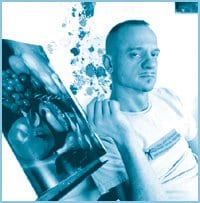In the almost 20 years since Attila Richard Lukacs first moved to Vancouver from his childhood home of Calgary, he has experienced recognition allotted few artists. It’s one thing to achieve a successful career based on depictions of babies dressed as vegetables. It’s quite another to receive mass kudos as an artist who delves deep into the primal and dark beauty of the human psyche, not to mention themes that are quite often unapologetically gay.
In the late ’80s and early ’90s, people couldn’t get enough of his paintings of naked skinheads in army boots or the unabashed maleness of his American military portraits. Lukacs became the art world’s It Boy and Bad Boy all rolled into one. From Time magazine to Adrienne Clarkson Presents to recently having one of this giant canvases used as a recurring prop in the loft apartment of one of the Queer as Folk television characters, Lukacs’ deft handling of complex and, at times, graphic subject matter has gained him mainstream visibility and notoriety.
Not bad for an Albertan art fag who moved to the coast to attend the Emily Carr Institute of Art and Design.
From his artist loft on Main Street, Lukacs explains that he only lived in Vancouver for three and a half years, from 1983 to 1986, prior to moving on to long stints in Munich and New York. But he still refers to Vancouver as home.
It’s the city he calls his “deepest base” and the city where he “formed intense bonds and friendships.” And it’s also where Lukacs chose to experiment with his relationship between his art space and his living space. Unlike the studios of thousands of square feet that he has grow accustomed to over the years, the Main street digs reflect a move to more humble origins or “a paper studio,” as Lukacs calls it.
While a photograph of a naked, bleeding, and heavily-pierced and tattooed skinhead, and paintings of primates, leave little doubt that the loft belongs to Lukacs, it’s the makeshift bedding and lack of luxury that initially surprise. With the exception of a black punching-bag hanging from the ceiling acquired after a frustration-induced wall punching incident that broke a knuckle, this looks very similar to the studios used by art students. This isn’t the Attila I expected.
When I tell Lukacs that some of his friends have described him as “a little bit of a diva,” he screams with an infectious laugh that continues to punctuate most of our interview. “My dad calls me a diva. He’ll say, ‘Rick, stop being a diva.’ And if he’s really mad at me, ‘stop being a goddamn diva.'”
True, he was rather late getting back to both this writer and the photographer, and he did cancel one of our meetings, but for the record, Attila Richard Lukacs is no Whitney Houston. If anything, he’s a slightly absent-minded artist who confesses he “would go crazy” if he didn’t work on his art. And he’s believable. A visitor can sense an absolute conviction from the artist. Just don’t expect him to make it to your dinner party on time.
His reference to his father is one of the many times he mentions his parents, a Calgary-based couple who don’t seem at all bothered by their son’s themes or subjects. The weekend before our interview, Lukacs’ parents attended a performance where their son sat naked, painting in front of an entire auditorium filled with members of the public as part of an artist-in-residence stint. “My dad begged me to put on overalls.”
When I ask him whether he’ll send a copy of his nudie cover to his mother, he says “absolutely! My parents understand my need for me to be me. My mother finally has clued into the fact that I’m a forty-year-old that never grew up.”
At a certain point in our interview I realize that we haven’t really touched on gay issues all that much, which seems strange given that I’ve been facing a painting of a man with a scrotal sack bound so tight it looks like an over-ripe plum. With the in-your-face and unapologetic nature of much of his work, it almost feels redundant to ask him about it. But I do. What follows is a series of rants about the commercialization of Pride parades, and how New York’s Christopher Street used to stand for something other than floating advertisements and how it wasn’t until a long stint in Maui that he could once again see a rainbow as a rainbow and not a tacky symbol for gayness.
The man’s as straightforward and fearless as his art.
JAKE.
Xeno gallery.
183 E. Broadway.
604.709.9934.

 Why you can trust Xtra
Why you can trust Xtra


